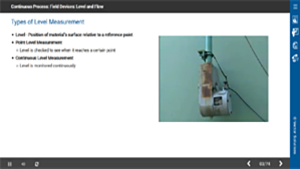RedVector
ACPLF00CEN
Define the following terms: level, point level measurement, continuous level measurement, direct level measurement, and indirect level measurement.
Identify common examples of point, continuous, direct, and indirect level measurement devices.
Identify factors that determine the type of level measurement device used for a particular application.
Define the following terms: density, specific gravity, and hydrostatic pressure.
Describe how pressure gauges, differential pressure transmitters, bubblers, and displacers provide level measurements.
Describe common applications and limitations associated with pressure gauges, differential pressure transmitters, bubblers, and displacers.
Describe factors that must be considered during the configuration of pressure gauges, differential pressure transmitters, bubblers, and displacers.
Describe how capacitance, or radio frequency (RF) devices, and conductance devices measure level.
Describe common applications and limitations associated with capacitance and conductance devices.
Describe factors that must be considered during the configuration of capacitance and conductance devices.
Describe how radar, ultrasonic, laser, and nuclear level measurement devices work.
Describe common applications and limitations associated with radar, ultrasonic, laser, and nuclear level measurement devices.
Describe how tuning fork sensors and weight devices provide level measurements.
Describe common applications and limitations associated with tuning fork sensors and weight devices.
Describe how differential pressure flow meters provide flow measurements.
Identify common primary flow elements that are used in differential pressure measurement.
Describe common problems that can affect the operation of differential pressure flow meters.
Describe how positive displacement flow meters measure flow.
Describe how turbine flow meters measure flow.
Describe applications and limitations associated with positive displacement flow meters and turbine flow meters.
Describe how magnetic, vortex, and ultrasonic flow meters measure flow.
Describe applications and limitations associated with magnetic, vortex, and ultrasonic flow meters.
Describe how Coriolis flow meters and thermal flow meters work.
Describe applications, limitations, and installation considerations for Coriolis flow meters and thermal flow meters.
Continuous Process: Field Devices: Level and Flow
Course Objectives
SUBJECT MATTER EXPERT: RedVector Industrial
RedVector Industrial leverages over 30 years of industrial training experience and a network of more than 200 subject matter experts to provide industrial facilities with engaging course content and technology-based training solutions that help assess and improve employee skills. We offer over 1,000 cutting-edge training courses that are designed to keep your employees safe, transfer knowledge of fundamentals, develop industry and job-specific skills and help your organization improve performance.

